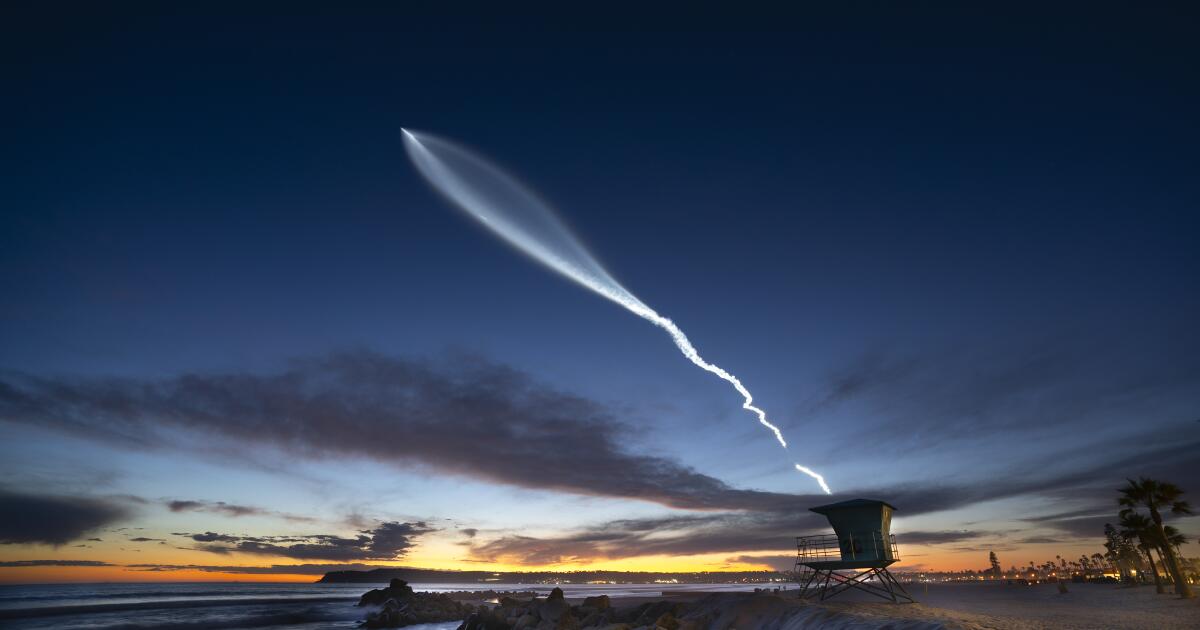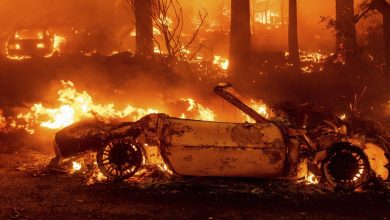Environmental concerns raised by rocket flights over San Diego County

Plans by SpaceX and other companies to increase the number of rocket launches sometimes seen in the skies of San Diego County have prompted the California Coastal Commission to question the environmental effects.
Residents near Vandenberg Space Base on the state’s central coast say the launches shake their homes and unnerve them. People don’t know when to expect them because the takeoff time varies and can be delayed by weather conditions.
“I find it hard to believe that there is no impact on (wildlife) species due to SpaceX launches,” Carpinteria resident Rebecca Stebbins said in an April 5 letter to the Commission coastal.
“I, along with thousands of other South Coast residents, are significantly impacted with each launch, including sometimes being awakened from a deep sleep, while my dogs are terrified, my house shakes and sonic booms go off. are felt physically. with deep shock.
Conservationists say the noise disrupts native wildlife, such as red-legged frogs, snowy plovers, seals and sea lions, and interferes with commercial and recreational fishing. Nearby public beaches and fishing areas are often closed during boat launches.
“The launches are extremely loud and destructive,” said Mandy Sackett in San Diego, senior California policy coordinator for the Surfrider Foundation.
“The noise impacts are grossly underestimated,” Sackett said, and she urged the Coastal Commission to “curb” the increase.
Another drawback is the latex weather balloons released before each flight to check atmospheric conditions. Balloons carry batteries and electronic components that reach the stratosphere then explode under pressure before falling back to land or the ocean, where the equipment sinks with little chance of recovery.
Up to 30 balloons were released before each launch until recently, a Vandenberg official said. A launch now only requires 10, and that number is decreasing as technology improves.
Space companies pay a $10 mitigation fee for every pound of irrecoverable debris they create, and the money goes into a fund for collecting lost fishing gear such as monofilament lines and nets. But commissioners, at their meeting Wednesday in Long Beach, said that amount may not be enough.
“A battery is hazardous waste,” said Commissioner Kristina Kunkel. “It’s not comparable to fishing gear.”
Air quality may be the first concern for anyone who saw the rocket’s long vapor trail, but reported emissions are well below applicable state and federal standards. The fuel is rocket-grade kerosene combined with liquid oxygen. When it burns, it produces a negligible amount of soot and nitrogen oxide in the exhaust gases.
The U.S. Space Force and SpaceX, owned by electric car mogul Elon Musk, have asked the Coastal Commission to approve an increase of up to 36 launches per year at Vandenberg. SpaceX launches have averaged six per year over the past five years, although they have increased steadily, reaching a total of 19 in 2022 and 28 in 2023.
The company is accelerating its launches by building a network of nearly 42,000 Starlink satellites to provide direct-to-cell Internet service worldwide. Each Falcon 9 rocket carries up to 22 satellites.
SpaceX also uses bases in Texas and Florida and, as of March, had launched more than 5,500 satellites. The company has a list of other launch customers, including NASA and the Pentagon.
The Coastal Commission made no decision on the request Wednesday. Instead, commissioners voted to postpone the matter so staff could examine the cumulative effects of the launches in more detail and return with more information in a month or more.
Other private companies and federal agencies are also launching rockets at Vandenberg. Last year, there were 37 launches total, said Col. Bryan Titus, Space Force vice commander for base operations.
“We’re asking for 36 right now (for SpaceX only) and we plan to ask for more later,” Titus said during Wednesday’s commission meeting. The base has the capacity to carry out up to 110 launches per year, a figure which could increase with the construction of an additional launch platform.
The launches are authorized based on the Coastal Commission’s prior determination that the environmental effects of the events are relatively insignificant. Additionally, questions arise about whether the state agency can regulate federal government actions that Titus says are vital to national security.
“All launches support the Department of Defense and our allies,” Titus said.
About 25% of all SpaceX rockets include a Department of Defense payload, he said. The United States also benefits from the company’s Starlink satellite system.
“Starlink has played an absolutely critical role in the situation in Ukraine,” he said, referring to U.S. support for the country in its war against Russia.
Landings of the rocket’s reusable first stage will also increase under the SpaceX plan, another concern of Central Coast residents.
Although the rocket launch creates a thunderous roar, it does not create a supersonic boom, Titus said. Only the return of the first stage, less than 10 minutes after takeoff, creates a sonic boom that can be heard 80 miles or more away, depending on atmospheric conditions.
The rocket stage can return to Vandenberg or, if that’s too far away, it can land on a floating platform at sea. SpaceX is also asking the Coastal Commission to allow an expansion of the ocean landing zone to cover an area beginning at least 31 miles from the coast and extending out to several hundred miles, anywhere between the latitudes of Los Angeles and mid-Baja. California.
At sea, landings take place on a barge-like drone that is towed to the general area. Once there, he can adjust his position remotely.
Some commissioners questioned the need for so many launches, especially when most of the profits go to private companies such as SpaceX and Firefly Aerospace, a Texas-based aerospace company.
Some commissioners said they would prefer to see statistics on all launches, including those by NASA, the Department of Defense and private companies. They also noted that no SpaceX representatives were present at the meeting.
“I am concerned about the fragmentation of this project,” said Commissioner Ann Notthoff. “We can’t really assess what this exponential growth is. We have to master this.
California Daily Newspapers





